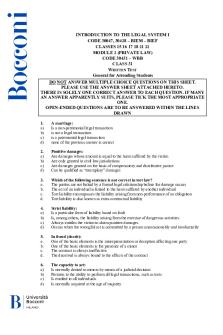Aircraft structures Mock Exam Third year PDF

| Title | Aircraft structures Mock Exam Third year |
|---|---|
| Author | Raeto |
| Course | Aircraft Structures |
| Institution | Philippine State College of Aeronautics |
| Pages | 5 |
| File Size | 134.3 KB |
| File Type | |
| Total Downloads | 19 |
| Total Views | 102 |
Summary
Download Aircraft structures Mock Exam Third year PDF
Description
Philippine State College of Aeronautics Piccio Garden, Villamor, Pasay City MOCK EXAMINATION AIRCRAFT STRUCTURES AND DESIGN (20%)
1) Which a. b. c. d.
is not a type of vibration? Noise Flutter Buffet None of the above
2) Pressurization is a type of a slowly applied load. What is the ATA chapter for pressurization? a. 20 b. 21 c. 22 d. 23 3) Flutter can be prevented by _____ to alter the moment of inertia of the surface. a. weight reduction b. pulling back on the control c. mass balancing control surfaces d. fuel jettisoning 4) The maximum positive maneuvering airplane are _____, respectively. a. 3.8 and 3.8 b. 3.8 and 4.4 c. 1.2 and 3.8 d. 3.8 and 6.0
load
factors
for
a
normal
and
an
acrobatic
5) An airplane’s center of lift is usually located aft of its center of gravity _____. a. so that the airplane will have a tail-heavy tendency b. to improve stability about the longitudinal axis c. so that the airplane will have a nose-heavy tendency d. to improve stability about the vertical axis 6) A support designed to allow only rotation at the point of connection, and thus reactive forces (reactions) are developed in the other directions where movements are not allowed. a. Fixed support b. Hinge support c. Hinge-roller support d. Wedge support 7) It occurs in intentional flight maneuvers in which the air loads on the wing are down or when the airplane strikes sudden downdrafts while in level flight. a. Positive High Angle of Attack b. Positive Low Angle of Attack c. Negative High Angle of Attack d. Negative Low Angle of Attack 8) It is the basic structure of an aircraft and is designed to withstand all aerodynamic forces, as well as the stresses imposed by the weight of the fuel, crew, and payload. a. Aircraft component b. Airframe c. Cabin system d. Landing Gear 9) It is a. b. c. d.
the slope of the initial straight portion of the stress-strain diagram. Modulus of Elasticity Hooke’s constant Modulus of Rigidity Poisson’s ratio
10) Calculate the load factor of an aircraft if the ratio of the centrifugal force and weight equals 4.20. a. 2.280 b. 2.317 c. 4.280 d. 4.317
11) The capacity of a material to absorb energy in the elastic range. a. Toughness b. Resilience c. Hardness d. Permeability 12) The limit load factor of a utility aircraft when its flaps are down is _____. a. 4.4 b. 3.8 c. 1.2 d. 2.2 13) It is known as the measurement of height in inches. It is perpendicular from a horizontal plane located at a ground, cabin floor, or some other easily referenced location. a. Aileron Station b. Butt Line c. Wing Station d. Water Line 14) It is obtained is where lift respectively. a. Positive b. Positive c. Negative d. Negative
in a pullout at the highest possible angle of attack on the wing. It and forces are perpendicular and parallel to the relative wind, High Angle of Attack Low Angle of Attack High Angle of Attack Low Angle of Attack
15) About a V-n diagram, it is the slowest speed at which the maximum load factor can be reached without stalling. a. VA b. VB c. VSX d. VS1 16) When looking the aircraft’s front view, the angle between the vertical line passing through the aircraft C.G. and the line between aircraft C.G. and the one of the main wheels is the _____. a. Angle of Incidence b. Overturn Angle c. Tipback Angle d. Tipforward Angle 17) An aircraft is flying at an altitude of 13,280 feet with a velocity of 180 feet per second. If the coefficient of lift is 1.35, what is the wing loading if the aircraft is in a steady-and-level, unaccelerated flight? a. 17.499 psf b. 31.417 psf c. 34.574 psf d. 80.807 psf 18) Loads that are gradually applied and cause no appreciable shock or vibration of structure. a. Static b. Dynamic c. Continuous d. Shock-resistant 19) What is the gust velocity for diving at 20,000 feet and below? a. 12.5 ft/s b. 25.0 ft/s c. 30.0 ft/s d. 50.0 ft/s 20) For a conventional, single-engine airplane of 6,000 pounds or less, the minimum design maneuvering speed is given by _____. a. 12.5 (n1w/s)0.5 b. 17.0 (n1w/s)0.5 c. 19.5 (n1w/s)0.5 d. 27.3 (n1w/s)0.5 21) A design airplane has a weight of 2,200 pounds and a wing area of 90 square foot. It is to be certified as an acrobatic under FAR part 23. What is the negative limit maneuvering load factor in which the airplane is designed for? a. 2.1
b. 3.8
c. 2.5 d. 3.0 22) Which a. b. c. d.
is not a type of gust? Sharp-edged gust Graded gust Blunt gust 1-cosine gust
23) It is a. b. c. d.
a flat sheet triangular shape used to reinforce the corners of structure. Webs Fittings Caps Gussets
24) In reference to a V-n diagram, it is the slowest speed at which the maximum load factor can be reached without stalling. a. VA b. VB c. VSX d. VS1 25) The tangent of this angle where the opposite side is the frictional force and the adjacent side is the normal force is called _____. a. bank b. friction c. incidence d. attack 26) It is essentially a beam which transmits and gathers all the applied airload to the central attachment to the fuselage. a. Wings b. Horizontal stabilizer c. Landing gear d. Dorsal fin 27) Which a. b. c. d.
among the following statements best describes a cantilever wing? Externally braced with either struts and /or bracing wires Supported at one end only with no external bracing Braced at both the upper and lower section of the airfoil Able to be folded at the root section to ease storage in confined spaces
28) In FAR Part 23, there must be a clearance of at least _____ between each propeller and the water. a. 7 inches b. 9 inches c. 18 inches d. 19 inches 29) It is strut a. b. c. d.
the maximum aircraft nose-up attitude with the tail touching the ground and fully extended. Angle of Incidence Overturn Angle Tipback Angle Tipforward Angle
30) Which among the following strain? a. Young’s Modulus law b. Hooke’s Law c. Poisson’s ratio d. Varignon’s Law
choices
articulates
the
relationship
of
stress
to
31) Normally designed to provide restraints against rotation and all translations; therefore, reactive forces and moments (reactions) are developed along the directions where movements are not permitted. a. Fixed support b. Hinge-roller support c. Wedge support d. Hinge support 32) It is the weight of the airframe structure, powerplant installation, and fixed equipment. It is essentially a “dry” weight, excluding unusable fuel and oil, antiicing fluid, portable water and chemicals in toilets. a. Operational Empty Weight (OEW)...
Similar Free PDFs

LLb third Year Syllabus
- 27 Pages

Mock exam
- 3 Pages

Mock Exam - exam
- 8 Pages

Introduction To Aircraft Structures T H
- 650 Pages

Mock Exam - exam
- 4 Pages

SBL MOCK EXAM 1
- 16 Pages

Mock Final Exam - Questions
- 11 Pages

MECO1001 Mock exam 2019
- 6 Pages

Mock exam 2019-2020
- 8 Pages

Revision & Mock Exam
- 22 Pages

Mock Exam C250 - Mock test questions
- 34 Pages

2020 nutrition mock exam
- 5 Pages
Popular Institutions
- Tinajero National High School - Annex
- Politeknik Caltex Riau
- Yokohama City University
- SGT University
- University of Al-Qadisiyah
- Divine Word College of Vigan
- Techniek College Rotterdam
- Universidade de Santiago
- Universiti Teknologi MARA Cawangan Johor Kampus Pasir Gudang
- Poltekkes Kemenkes Yogyakarta
- Baguio City National High School
- Colegio san marcos
- preparatoria uno
- Centro de Bachillerato Tecnológico Industrial y de Servicios No. 107
- Dalian Maritime University
- Quang Trung Secondary School
- Colegio Tecnológico en Informática
- Corporación Regional de Educación Superior
- Grupo CEDVA
- Dar Al Uloom University
- Centro de Estudios Preuniversitarios de la Universidad Nacional de Ingeniería
- 上智大学
- Aakash International School, Nuna Majara
- San Felipe Neri Catholic School
- Kang Chiao International School - New Taipei City
- Misamis Occidental National High School
- Institución Educativa Escuela Normal Juan Ladrilleros
- Kolehiyo ng Pantukan
- Batanes State College
- Instituto Continental
- Sekolah Menengah Kejuruan Kesehatan Kaltara (Tarakan)
- Colegio de La Inmaculada Concepcion - Cebu



